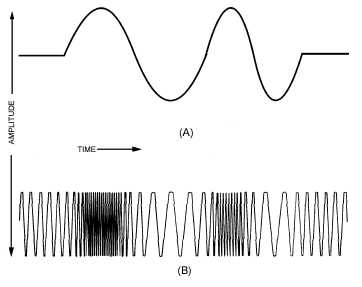2-9
of times per second that the instantaneous frequency is varied from the average (carrier frequency) is
controlled by the frequency of the modulating signal. The amount by which the frequency departs from
the average is controlled by the amplitude of the modulating signal. This variation is referred to as the
FREQUENCY DEVIATION of the frequency-modulated wave. We can now establish two clear-cut rules
for frequency deviation rate and amplitude in frequency modulation:
Figure 2-5.—Effect of frequency modulation on an rf carrier.
AMOUNT OF FREQUENCY SHIFT IS PROPORTIONAL TO THE AMPLITUDE OF THE
MODULATING SIGNAL
(This rule simply means that if a 10-volt signal causes a frequency shift of 20 kilohertz, then a
20-volt signal will cause a frequency shift of 40 kilohertz.)
RATE OF FREQUENCY SHIFT IS PROPORTIONAL TO THE FREQUENCY OF THE
MODULATING SIGNAL
(This second rule means that if the carrier is modulated with a 1-kilohertz tone, then the carrier is
changing frequency 1,000 times each second.)
Figure 2-6 illustrates a simple oscillator circuit with the addition of a condenser microphone (M) in
shunt with the oscillator tank circuit. Although the condenser microphone capacitance is actually very
low, the capacitance of this microphone will be considered near that of the tuning capacitor (C). The
frequency of oscillation in this circuit is, of course, determined by the LC product of all elements of the
circuit; but, the product of the inductance (L) and the combined capacitance of C and M are the primary
frequency components. When no sound waves strike M, the frequency is the rf carrier frequency. Any
excitation of M will alter its capacitance and, therefore, the frequency of the oscillator circuit. Figure 2-7
illustrates what happens to the capacitance of the microphone during excitation. In view (A), the audio-
frequency wave has three levels of intensity, shown as X, a whisper; Y, a normal voice; and Z, a loud
voice. In view (B), the same conditions of intensity are repeated, but this time at a frequency twice that of
view (A). Note in each case that the capacitance changes both positively and negatively; thus the
frequency of oscillation alternates both above and below the resting frequency. The amount of change is
determined by the change in capacitance of the microphone. The change is caused by the amplitude of the
sound wave exciting the microphone. The rate at which the change in frequency occurs is determined by

